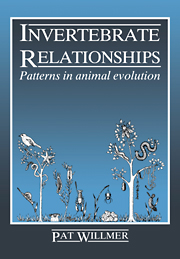Crossref Citations
This Book has been
cited by the following publications. This list is generated based on data provided by Crossref.
Valentine, James W.
1991.
Constructional Morphology and Evolution.
p.
389.
Chisholm, Andrew
1991.
Control of cell fate in the tail region of C. elegans by the gene egl-5
.
Development,
Vol. 111,
Issue. 4,
p.
921.
Barnes, R. S. K.
1991.
Two-layered awakening.
Nature,
Vol. 350,
Issue. 6319,
p.
561.
MORRIS, PAUL
and
COBABE, EMILY
1991.
Cuvier meets Watson and Crick: the utility of molecules as classical homologies.
Biological Journal of the Linnean Society,
Vol. 44,
Issue. 4,
p.
307.
Davidson, Eric H.
1991.
Spatial mechanisms of gene regulation in metazoan embryos.
Development,
Vol. 113,
Issue. 1,
p.
1.
1991.
A molecular analysis of the phylogenetic affinities of
Saccoglossus cambrensis
Brambell & Cole (Hemichordata)
.
Philosophical Transactions of the Royal Society of London. Series B: Biological Sciences,
Vol. 332,
Issue. 1264,
p.
185.
Willmer, P. G.
and
Holland, P. W. H.
1991.
Modern approaches to metazoan relationships.
Journal of Zoology,
Vol. 224,
Issue. 4,
p.
689.
Crowther, Robert J.
and
Whittaker, J. R.
1992.
Structure of the caudal neural tube in an ascidian larva: Vestiges of its possible evolutionary origin from a ciliated band.
Journal of Neurobiology,
Vol. 23,
Issue. 3,
p.
280.
Wolpert, L.
1992.
Gastrulation and the evolution of development.
Development,
Vol. 116,
Issue. Supplement,
p.
7.
Fryer, Geoffrey
1992.
The Origin of the Crustacea*.
Acta Zoologica,
Vol. 73,
Issue. 5,
p.
273.
Dodds, A. W.
and
Day, A. J.
1993.
Complement in Health and Disease.
p.
39.
Morris, Paul J.
1993.
THE DEVELOPMENTAL ROLE OF THE EXTRACELLULAR MATRIX SUGGESTS A MONOPHYLETIC ORIGIN OF THE KINGDOM ANIMALIA.
Evolution,
Vol. 47,
Issue. 1,
p.
152.
Lane, R. P.
1993.
Medical Insects and Arachnids.
p.
30.
Morris, S. Conway
1993.
The fossil record and the early evolution of the Metazoa.
Nature,
Vol. 361,
Issue. 6409,
p.
219.
Backeljau, Thierry
Winnepenninckx, Birgitta
and
Bruyn, Luc De
1993.
CLADISTIC ANALYSIS OF METAZOAN RELATIONSHIPS: A REAPPRAISAL.
Cladistics,
Vol. 9,
Issue. 2,
p.
167.
Budd, Graham
1993.
A Cambrian gilled lobopod from Greenland.
Nature,
Vol. 364,
Issue. 6439,
p.
709.
Moore, Janet
and
Gibson, Ray
1993.
Methods of classifying nemerteans: an assessment.
Hydrobiologia,
Vol. 266,
Issue. 1-3,
p.
89.
Page, Louise R.
1993.
Developmental analysis reveals labial and subradular ganglia and the primary framework of the nervous system in nudibranch gastropods.
Journal of Neurobiology,
Vol. 24,
Issue. 11,
p.
1443.
ERWIN, DOUGLAS H.
1993.
The origin of metazoan development: a palaeobiological perspective.
Biological Journal of the Linnean Society,
Vol. 50,
Issue. 4,
p.
255.
Slack, J. M. W.
Holland, P. W. H.
and
Graham, C. F.
1993.
The zootype and the phylotypic stage.
Nature,
Vol. 361,
Issue. 6412,
p.
490.





